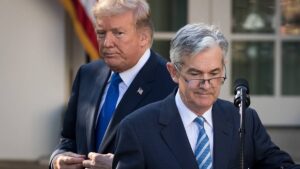Think Big: Budget blowouts and rates updates – what to watch for on October 6

With the federal budget following the RBA's rates announcement, Tuesday will be a big one on the policy front. (Pic: Getty)
Analysts are predicting record budget deficits and a possible interest rate cut in November, ahead of ‘Team Australia’ policy day on October 6.
The RBA’s monthly interest rate announcement will be followed by the federal government’s delayed budget – two key updates on how policy support measures will be maintained into the future.
With big budget deficits “very much the dominant theme around the world right now”, CBA’s domestic economics head Gareth Aird says this one will be no different.
Record budget deficits
The CBA team is forecasting a budget deficit in the 2021 financial year of $220bn, which is around $35bn higher than the government forecast in its July economic and fiscal update (JEFU).
The UBS economics team reckons the FY21 deficit will be slightly larger, at $235bn.
And last week CBA rates strategist Philip Brown flagged a possible figure in the ballpark of $250bn, based on the extent of recent debt issuance by the Australian Office of Financial Management.
“At 12 per cent of GDP, the deficit is the largest since World War 2, and around three times larger than the global financial crisis (GFC),” UBS said.
Looking at the state of play since July 23, Aird said there’s been a couple of upside surprises on the revenue side.
Domestic consumption has held up better than feared, despite the lockdowns in Victoria.
And iron ore prices kept on climbing, whereas the government’s forecasts had priced in a fall.
UBS said that iron ore prices alone should add around $10bn to the final amount.
But those gains will be outweighed by subsequent increases on the expenditure side since JEFU was announced.
That includes a relaxation on eligibility restrictions for JobKeeper due to the extended lockdown in Victoria, as well as additional measures for infrastructure spending expected to be announced on budget night.
Already, the Morrison government has flagged a $1.5bn support program to boost Australia’s manufacturing capability.
And Treasurer Josh Frydenberg recently said the government would only reduce its support measures in stages as the economy recovered.
However, at this stage all COVID-19 fiscal spending changes are forecast to roll off by the middle of next year. That should see the FY22 deficit reduce to around $100bn, UBS said.
Aird said a boost to GDP should flow through to an improved bottom line in 2021-22, but it would still be a large deficit – in the order of around $110bn.
Monetary policy
A few hours before the budget, the RBA will make its monthly interest rates announcement at 2:30pm EST.
The unprecedented policy double-shot has raised speculation among analysts that there’ll be another round of ‘Team Australia’ support measures, similar to the initial response back in March.
For the most part, the RBA has communicated it has no plans to lower interest rates further from their current level of 0.25 per cent.
With October 6 fast approaching, a speech from RBA deputy governor Guy Debelle on September 22 was closely scrutinised for any clues as to the bank’s outlook.
At the time, Westpac chief economist Bill Evans said Debelle’s comments offered a “fairly clear hint” the bank was preparing to cut rates again on Budget Day.
However, as the market’s response to Debelle’s speech played out over the following days, Evans changed his view – rate cuts are still coming, but not for another month.
Evans poured cold water on the idea the RBA would hold off on cutting rates before it saw what was in the budget.
Historically, he said the RBA had changed rates a week before the budget no less than eight times.
However, “in the eyes of the authorities, there was probably a trade-off between a ‘Team Australia’ moment and the government having the clear air to sell its Budget without any distractions from other policy makers”, Evans said.
And looking at the broader economic fallout from COVID-19, the rationale for a rate cut is still in play.
Which means Westpac’s original call for the RBA to trim rates further to 0.1 per cent is on the cards, but is more likely to take place on November 3.
Related Topics
UNLOCK INSIGHTS
Discover the untold stories of emerging ASX stocks.
Daily news and expert analysis, it's free to subscribe.
By proceeding, you confirm you understand that we handle personal information in accordance with our Privacy Policy.








